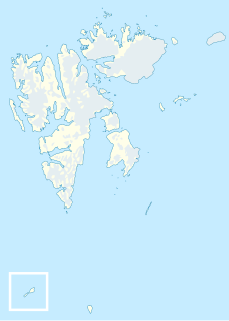
Lågøya is an island in Svalbard, Norway. It is situated north west of Nordaustlandet. The area is 103.5 km². The island has rarely been visited.

Storfjorden is the body of water separating Spitsbergen in the west from Barentsøya and Edgeøya to the east. Its southern limits are Kikutodden in Sørkapp Land east to Håøya, Tiholmane, Brækmoholmane, and Menkeøyane in Thousand Islands and northeast to Negerpynten—the southeastern promontory of Edgeøya. Its limits on its eastern side are Sundneset on the northern side of Freemansundet south to Palibinramten on the northwest coast of Edgeøya. The northern part is called Ginevra Bay, which lies between Olav V Land and Barentsøya. It ends at Heleysundet.

Bellsund is a 20-kilometer (12 mi) long sound on the west coast of Spitsbergen, part of the Svalbard archipelago of Norway. It is separated from Van Mijenfjorden by the islands of Akseløya and Mariaholmen. Bellsund is located south of Nordenskiöld Land and north of Wedel Jarlsberg Land.

Thousand Islands is a group of small islands south of Edgeøya. They form part of the Svalbard archipelago. The group consists of over forty islands and islets, including Brotskjer, Kulstadholmane, Utsira, Tufsen, Kong Ludvigøyane, Bölscheøya, Hornøya, Tiholmane, Meinickeøyane, Sletteøya, Schareholmane, Skråholmen, Brækmoholmane, Tareloppa, Vindholmen, and Menkeøyane.

Heleysundet is a narrow sound between Kükenthaløya and Spitsbergen. It is known for its violent tidal races.
Tjuvfjorden is a 45 km long and up to 30 km wide fjord separating Edgeøya’s two southern promontories, Kvalpynten and Negerpynten.

Bölscheøya is an island southwest of Negerpynten, the southeastern point of Edgeøya. It is part of Thousand Islands. The island was named in 1868 by the German geographer August Petermann (1822–78) after the German journalist Carl Bölsche, father of the German writer and zoologist Wilhelm Bölsche (1843–93). The remains of a whaling station from the 17th century can be found on the island.

Kong Ludvigøyane is a small group of islands south of southwestern Edgeøya. The group includes Russebuholmane, Arendtsøya, Berentine Island, and Bruhnsøya. They form part of Thousand Islands. They are named after King Ludwig II (1845–86) of Bavaria, Germany. The islands may be the Hopeless Iles of the Muscovy Company's map (1625).

Meinickeøyane is an island group composed of two islets, Store Meinickeøya and Vesle Meinickeøya, that form part of Thousand Islands, an island group south of Edgeøya, part of the Svalbard archipelago. They were named after the German geographer Carl Eduard Meinicke (1803–76).
Lurøya is the largest island in Tiholmane, part of Thousand Islands, an island group south of Edgeøya.
Teisten is an islet in Menkeøyane, part of Thousand Islands, a Norwegian island group south of Edgeøya.
Arendtsøya is a small island in Kong Ludvigøyane, part of Thousand Islands, an island group south of Edgeøya. The island is named after the German geographer Karl Arendts (1815–81).
Bruhnsøya is a small island in Kong Ludvigøyane, an island group in Thousand Islands, an archipelago south of Edgeøya. The island is named after the German astronomer Carl Christian Bruhns (1830–81).
Islomen is a small rocky island, or skerry, in the southeastern part of Menkeøyane, part of Thousand Islands, a Norwegian archipelago south of Edgeøya.
Blåmåken is the northeasternmost island in Menkeøyane, part of Thousand Islands, a Norwegian archipelago south of Edgeøya.
Alka is a Norwegian islet between Gassen and Havella in Menkeøyane, part of Thousand Islands, an archipelago south of Edgeøya.
Gassen is the westernmost of the large islets in Menkeøyane, part of Thousand Islands, a Norwegian archipelago south of Edgeøya.
Havella is the largest islet in Menkeøyane, part of Thousand Islands, a Norwegian archipelago south of Edgeøya. It is named after the long-tailed duck, a migrant to Svalbard.

Heinrich Theodor Menke was a German geographer, who was born and lived in Bremen. He is remembered for his work in historical geography.










